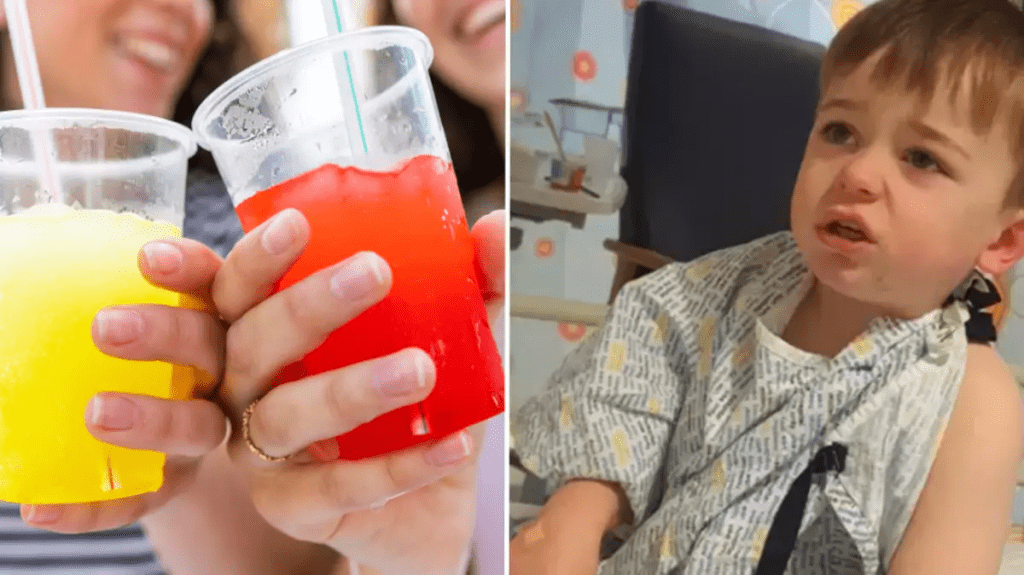What started as an innocent family outing turned into a nightmare for Beth Green and Fred Pegg when their four-year-old son, Albie, nearly lost his life after consuming a slushy drink. The strawberry-flavored treat, meant to be a fun indulgence during a visit to a local bowling alley in Warwickshire, UK, became the catalyst for a terrifying medical emergency. Albie’s story shines a light on the hidden dangers of a common childhood favorite: slushy drinks.
The Day That Took a Sudden Turn

Albie’s day began like any other. Along with his friend, he was excited to enjoy a day of fun and games. As part of their outing, the boys were treated to a colorful, strawberry-flavored slushy drink—an ordinary refreshment that many children consume without a second thought. For Albie, however, this seemingly harmless drink would soon cause his parents unimaginable distress.
Within just an hour of finishing the slushy, Beth noticed a disturbing change in her son’s behavior. “He went from cheerful to agitated and fatigued in the blink of an eye,” she recounted. Albie soon lost consciousness, prompting his panicked parents to rush him to the hospital. As they sped toward the emergency room, Albie’s condition worsened, and his heartbeat dropped alarmingly low. The journey felt like an eternity for Beth and Fred, who feared they might lose their child over something so simple as a slushy drink.
The Medical Emergency and Albie’s Recovery
Once at the hospital, medical staff worked tirelessly to stabilize Albie’s condition. His heart rate continued to drop, and the situation grew increasingly dire. Beth described those moments as agonizing, filled with helplessness and fear as they awaited any sign of improvement.
Fortunately, after three nerve-wracking days in the hospital, Albie began to show signs of recovery. Doctors eventually determined that his near-fatal condition was linked to a previously undiagnosed glycerol intolerance. Glycerol, a common ingredient in slushy drinks, had triggered an adverse reaction in Albie, leading to severe symptoms that escalated rapidly.
Although Albie was on the road to recovery, the trauma of the incident left a lasting impact on his parents. “We were so close to losing him,” Beth shared. “It’s terrifying to think that something so ordinary could have such dangerous consequences.”
Understanding the Hidden Dangers of Slushy Drinks
Many parents are unaware that glycerol, a key ingredient in slushy drinks, can pose serious risks to young children. Glycerol, a sweet-tasting compound used to prevent the drink from freezing solid, may seem harmless, but in certain children—especially those with glycerol intolerance—it can cause life-threatening reactions. Excessive glycerol consumption has been linked to symptoms such as shock, hypoglycemia (low blood sugar), and loss of consciousness, much like what Albie experienced.
The incident raises crucial questions about the safety of such popular beverages. If something as ubiquitous as a slushy drink can cause such severe health issues, what other hidden dangers might parents be unaware of?
The Food Standards Agency Steps In

In light of incidents like Albie’s, the UK’s Food Standards Agency (FSA) has taken steps to regulate the sale of slushy drinks to children. Recognizing the potential risks of glycerol, the FSA has issued new guidelines, recommending that slushy drinks should not be sold to children under four years old. Additionally, they’ve implemented restrictions on free refill promotions for children under the age of 10, aiming to limit excessive consumption.
These guidelines represent a significant step forward in protecting young children from the potential dangers associated with slushy drinks, but there’s still more work to be done. Awareness among parents and guardians is crucial to ensuring children’s safety, particularly when it comes to products that may seem harmless at first glance.
Parents Advocate for Greater Awareness
Beth and Fred, still reeling from their terrifying experience, have taken it upon themselves to raise awareness about the risks of slushy drinks and glycerol intolerance. Their message is clear: parents must be vigilant about what their children consume, and they shouldn’t assume that all childhood treats are free from risk.

“We never would have imagined that a slushy could be dangerous,” Beth explained. “It’s something kids drink all the time, and there was no warning.” Now, the couple is urging other parents to educate themselves about the potential hazards of these drinks and to pay attention to any unusual reactions their children may have after consuming them.
Their advocacy extends beyond just sharing Albie’s story. They are calling for even stricter regulations on the sale of slushy drinks to young children and for more comprehensive labeling that highlights the presence of glycerol and its potential risks.
The Importance of Child Safety in Everyday Treats
Albie’s near-death experience serves as a sobering reminder that even the most ordinary, everyday treats can pose hidden dangers. As parents, it’s easy to assume that foods and drinks commonly available to children are safe, but Albie’s story challenges this assumption. The fragility of young children, especially those with undiagnosed intolerances or medical conditions, demands a higher level of vigilance from both parents and retailers.

By raising awareness and advocating for stronger regulations, parents like Beth and Fred are helping to ensure that future tragedies can be prevented. Albie’s ordeal may have had a happy ending, but not all families are so fortunate. The key to preventing similar incidents is education, awareness, and proactive measures to ensure that children’s health and safety always come first.
Conclusion
The story of Albie’s close call with a seemingly innocent slushy drink is a wake-up call for parents and regulators alike. While Albie was lucky to recover after his terrifying ordeal, his experience highlights the hidden dangers lurking in everyday treats. Glycerol, a common ingredient in slushy drinks, can be life-threatening for some children, and the need for greater awareness, stricter regulations, and proactive safety measures is clear.
Beth and Fred’s advocacy serves as a reminder that as parents, we must always be vigilant about what our children consume. With increased education, better labeling, and stricter guidelines in place, we can work together to prevent future incidents and ensure that every child can enjoy their favorite treats without risking their health. Albie’s story is a powerful lesson in the importance of awareness and safety—one that should never be forgotten.


